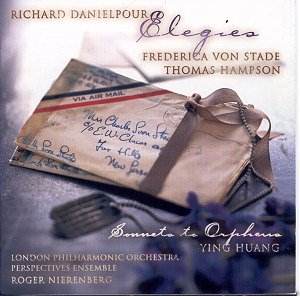 Composer: Richard Danielpour (born 1956)
Composer: Richard Danielpour (born 1956)
Works: Elegies (1997), Sonnets to Orpheus (1992)
Performers: Frederica von Stade (mezzo-soprano), Thomas Hampson (baritone), Ying Huang (soprano), London Philharmonic Orchestra, Perspectives Ensemble, Roger Nierenberg
Recorded: Henry Wood Hall, London, September 1998 (Elegies); American Academy of Arts & Letters, New York City, April 2000 (Sonnets)
Label: SONY SK 60850
Duration: 65:27
In the realm of contemporary American classical music, Richard Danielpour’s compositions have emerged as deeply expressive and insightful, often drawing upon personal narratives that resonate on a universal level. This latest release from SONY, featuring the song cycles Elegies and Sonnets to Orpheus, not only showcases the continuing evolution of Danielpour’s voice but also provides a poignant reflection on themes of loss, memory, and the search for connection across time and space.
Elegies, completed in 1997, is a compelling work born from the intimate and tragic history of Frederica von Stade’s familial narrative. The genesis of this song cycle is particularly notable: its foundation rests upon letters from von Stade’s father, who perished in World War II before her birth. Danielpour’s setting, with texts by Kim Vaeth, unfolds in five sections, each imbued with evocative orchestral colors and lyrical poignancy. The opening section, Vigil, introduces the listener to a sound world marked by tolling bells that resonate with the weight of absence. The mezzo-soprano’s yearning for connection with her father is rendered through a melodic line that is at once lyrical and haunting, encapsulating the essence of longing.
The orchestration throughout Elegies is rich and varied, with Danielpour demonstrating a keen ear for instrumental color. In the second section, Lacrimosa, the music shifts dramatically to convey the brutality of war, characterized by martial and jagged rhythms. Hampson’s baritone voice emerges as a powerful anchor amidst this turmoil, with his plaintive cry of “Where is my beloved?” echoing the desperation of a father seeking solace in a world shattered by conflict.
Frederica von Stade’s performance throughout the cycle is nothing short of revelatory; her voice, with its characteristic warmth and richness, imbues each phrase with a depth of emotion that is both personal and archetypal. The concluding section, In Paradisum, radiates a hard-won serenity, encapsulating the journey from grief to acceptance, with Danielpour’s orchestral writing culminating in a tender, almost ethereal coda.
Contrasting sharply with Elegies, Sonnets to Orpheus was completed in 1992 and features a smaller ensemble that allows for a more intricate interplay between voices and instruments. The work is inspired by Rainer Maria Rilke’s sonnets, translated into English by Stephen Mitchell, and showcases Danielpour’s expansive imagination. The prologue begins with a bold horn invocation, setting a contemplative mood that is further enriched by the cello’s lyrical outpouring. The Dance the Orange section introduces a sense of humor through a tango that is both playful and unsettling, capturing the essence of Rilke’s duality.
Ying Huang’s performance of the soprano lines in Sonnets to Orpheus is particularly noteworthy; her voice floats effortlessly over the ensemble, creating a sense of ethereality that is essential to the work’s emotional landscape. The juxtaposition between the lighter, jazzy elements of the Tarantella and the deeply moving Anthem reveals Danielpour’s ability to navigate contrasting moods with remarkable finesse. The latter builds to a climactic lament, ultimately resolving into the serene and elegiac Epilogue, which serves as a poignant farewell to the cycle.
In terms of historical significance, both works reflect Danielpour’s commitment to accessible yet sophisticated musical language, echoing the practices of earlier American composers such as Samuel Barber and David Piston. His reliance on melody and clear text setting renders the music approachable, while still maintaining a contemporary sensibility that avoids the extremes often associated with modernist compositions.
The engineering quality of this recording merits attention as well; the balance between voices and orchestra is meticulously crafted, allowing for clarity of text and instrumental interplay. Each nuance of Danielpour’s orchestration is captured with precision, enhancing the overall listening experience.
Ultimately, this release represents a significant addition to the recorded canon of Richard Danielpour’s work, offering both newcomers and seasoned listeners a profound exploration of human emotions through music. The combination of compelling narratives, masterful vocal writing, and rich orchestral textures creates a tapestry that is deeply affecting and deserving of repeated hearings. For those who appreciate the lyrical and communicative qualities of American art song, this recording of Elegies and Sonnets to Orpheus is a compelling invitation to immerse oneself in the complexities of love, loss, and the enduring power of memory.
